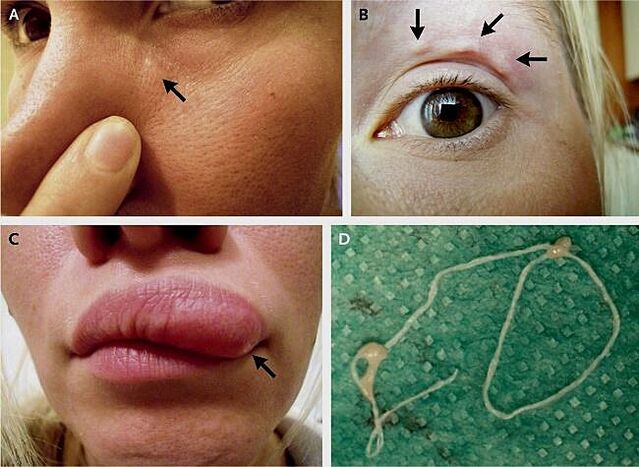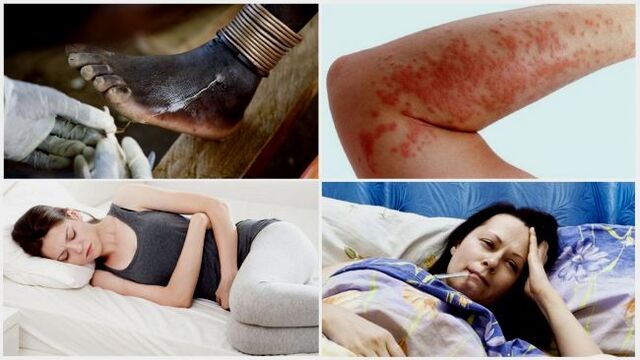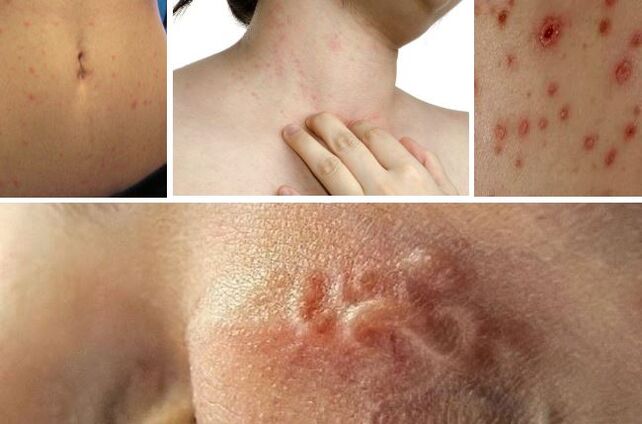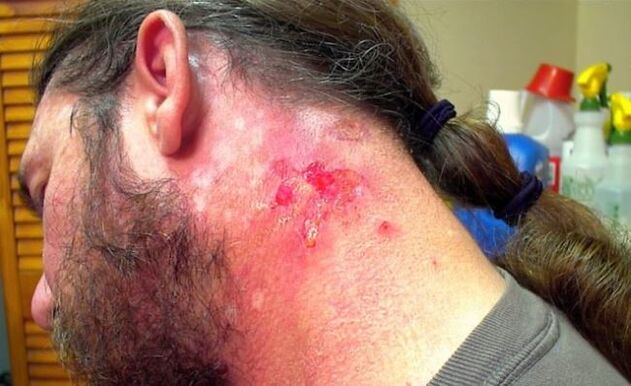Subcutaneous parasites, living in the thickness of human skin, damage it and cause inflammation. They can penetrate from the main place of "deployment" to other organs and trigger serious illness. Most subcutaneous helminths are found in southern countries, and ordinary people can be infected with them while on vacation or business trip there.
The danger of subcutaneous helminthic invasion is that it is asymptomatic during the incubation period, which can last for many years. This in turn interferes with treatment and reduces its effectiveness.

Are subcutaneous parasites
Helminths affect not only a person’s internal organs, but also his or her skin. Going into its thickness, they damage the epidermis, eat away at its cells and defecate. Subcutaneous worm waste products cause intoxication, because they contain toxic substances. And the longer the worm is under a person’s skin, the more obvious the symptoms of aggression.
Subcutaneous worms cause many diseases, as they affect the immune and lymphatic systems of the human body. For example, parasites can trigger the development of elephantism - elephantiasis. It interferes with the circulation of lymph in the body. This leads to an increase in the number of limbs and their deformities. In the last stage, the affected organ becomes covered with ulcers, necrosis develops.

Human helminths that live under the skin include:
- Nematodes of the genus Dirofilaria. Causes dirofilariasis. Infection of the body occurs through the bite of blood -sucking insects: fleas, ticks, ticks, which are carriers of larvae from one host to another. Adult dirofilaria can reach 30 cm in length. The process of reproduction takes place in the thickness of the skin, then the female puts the microfilaria into the bloodstream.
- Filariae. Causes filariasis. They are parasitic ringworms. An adult can reach almost half a meter, while the body diameter is not more than 0. 3 mm. Carriers of filariasis are blood -sucking insects that transmit parasitic larvae from one host to another.
- Caterpillar larvae. Someone triggers the development of cysticercosis. Infection occurs through the intestines, where parasite eggs penetrate along with water, food, feces. After that, under the influence of gastric juice, the shell dissolves - the larvae come out. Then they are carried throughout the body along with the bloodstream.
- Blood flukes of the genus Schistosoma. It is called schistosomiasis. An adult can reach 2 cm in length. Reproduction occurs through the penetration of larvae into the body - cercariae along with water.
Main manifestations and treatment
If a person has parasites under the skin, then first of all this is reflected in his condition: flabbiness appears, discoloration, scars and microcracks appear. This is due to the fact that the "guests" damage the skin, eat its cells and poison the waste products.

Subcutaneous parasites in humans cause symptoms of helminthic invasion:
- Allergic rash;
- Cough;
- Decreased immunity;
- Itching;
- Peeling, redness of the skin;
- appetite problems;
- Pain in joints and muscles;
- Sleep disorders;
- Irritation;
- indifference.
Skin parasites in sick people cause damage to the whole organism: developing anemia, dysbacteriosis, etc.
Treatment of parasitic diseases is selected individually. The choice of method is influenced by the degree of damage to the body, symptoms and type of pathogen. In some cases, in addition to drug treatment, surgery may be needed to remove the helminth from under the skin or even the entire organ that has been affected.
Along with antihelminthic drugs, antihistamines, vasoconstrictors are used. If the inflammation has started due to worms living under the skin, then antibiotic therapy is needed.
You should not try to get rid of helminths that live under the skin with the help of traditional medicine itself - as practice has shown, they are ineffective and can endanger human health.
Symptoms of filariasis
The subcutaneous worms that cause the disease - filariae - appear in the human body after the bite of an insect infected with a blood sucker. The highest number of cases were recorded in tropical and subtropical countries.
Subcutaneous worms in humans can live in the human body and do not manifest themselves for a long time: the incubation period of the disease can last up to 7 years. This makes diagnosis difficult.

Symptoms and manifestations of invasion appear gradually, as the parasite grows under a person’s skin and its effect on the surrounding tissues. The most common manifestations of filariasis include:
- Hives;
- Itching;
- warts;
- eczema;
- Small hard lumps under the skin.
As the disease worsens, fever, general weakness, headache, and drowsiness may occur.
Treatment of filariasis should be done in a hospital setting. For deworming, antiparasitic drugs are used. The effectiveness of therapy is monitored by blood tests. In cases where it does not help, the sick person undergoes a surgical operation to restore the outflow of lymph from the affected organ.
Cysticercosis and schistosomiasis
Tapeworm larvae cause cysticercosis. This type of helminth is distinguished by survival: enough for one parasite to enter the human body and it will quickly develop into an adult, which will then begin to multiply.
This feature makes it difficult to treat the disease - if the head segment remains after surgery to remove the worms, the parasite will grow back. Despite the fact that adult tapeworms are located in the human intestine, their larvae spread throughout the body with the bloodstream, including under the skin. After that, they can live there for a long time - from 5 to 30 years.
If, with cysticercosis, the worm is rolled under the skin or in the muscle tissue, then for a person the disease is asymptomatic. However, the location of the parasite can be determined by the tumor -like neoplasm that will rise above the skin. On palpation of the tubercle, it can be determined that it is hollow inside. The skin of the shoulders, upper chest, and palms are usually the favorite sites of tapeworm larvae.
With subcutaneous cysticercosis, medication is not carried out, the patient should be under the supervision of a physician. This is due to the fact that when the parasite dies after the use of antiparasitic agents, toxins begin to enter the body. They, in turn, can give a strong allergic reaction.
Schistosoma larvae, cercariae cause schistosomiasis in humans. Infection occurs through water. The first symptoms of worms under the skin appear 10-15 minutes after the invasion. This is due to the fact that worms under the skin secrete large amounts of their own secretory fluid, which causes a toxic allergic reaction in a person.
First manifestation:
- Severe itching;
- Hives;
- Rash.
Then there is a pause, after which (after 1-2 months) the acute stage of schistosomiasis begins, which indicates neglect of the disease:
- Fever;
- Nocturnal hyperhidrosis;
- Hives;
- Dry cough;
- Changes in the qualitative composition of blood.
Currently, treatment of schistosomiasis is limited to the use of 2 anthelmintic drugs. In the acute stage of the disease, steroids, antihistamines, anti-inflammatory drugs are also used.
Dirofilaria and Morgellon virus
Both diseases have similar symptoms, with some differences. With dirofilariasis, the sick person finds in his body a small tubercle under the skin, which moves during palpation. This indicates that the subcutaneous worm has curled up in the body. A similar invasive manifestation was observed with Morgellon virus.

An important difference between these two parasites is that dirofilaria do not bother their hosts: bubbles under the skin do not cause discomfort, they can appear and disappear over time. Parasitic worms on the arms, legs, near the eyes, nose, on the chest, in men - on the genitals. If dirofilaria is under a person's skin for a long time, then under the influence of toxins, his body temperature rises and weakness is felt.
With Morgellon virus, severe itching is felt on the skin of helminthic invasion. In the absence of medical help, bleeding wounds, eczema, soon appear. This increases the risk of infection of the body with other diseases several times.
The best treatment for parasites is surgical removal.






































